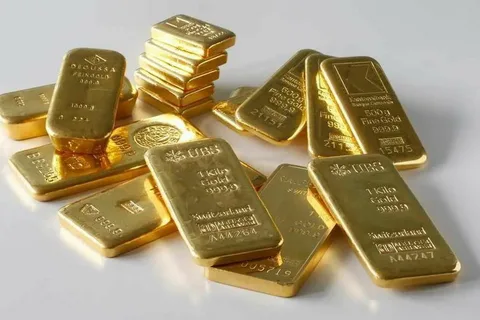The price of gold has always been a topic of interest and discussion, especially among investors and those who closely follow the financial markets. The fluctuating price of gold has a significant impact on various sectors, and understanding these fluctuations is crucial for making informed decisions. In this article, we will explore the rising and falling trends of the price of gold, and delve into the factors that contribute to its fluctuations. Whether you’re a seasoned investor or simply curious about the dynamics of the gold market, gaining insight into the price of gold is essential for navigating the ever-changing world of finance.
Rising and Falling: The Fluctuating Price of Gold is a book that delves into the historical and economic factors that contribute to the unpredictable nature of gold prices. It explores how various events, such as economic crises, political unrest, and changes in monetary policy, can affect the value of gold. The book also examines the role of gold as a safe haven asset and its significance in the global economy. Additionally, the author provides insights into the strategies and considerations for investors and traders who are interested in capitalizing on the fluctuations in gold prices.
The Impact of Inflation on the Price of Gold

The impact of inflation on the price of gold is significant. In times of high inflation, the purchasing power of currency decreases, causing investors to seek alternative stores of value. Gold is often seen as a hedge against inflation because its value tends to rise when the value of fiat currency declines. As a result, the price of gold typically increases during periods of inflation, making it an attractive investment for those looking to preserve their wealth. This relationship between inflation and the price of gold has been observed throughout history and is a key factor in the dynamics of the gold market.
Factors Affecting the Fluctuating Price of Gold

There are several factors that can affect the fluctuating price of gold, including supply and demand, inflation rates, interest rates, and political and economic instability.
Supply and demand play a significant role in determining the price of gold. If the demand for gold increases while the supply remains constant, the price of gold is likely to go up. Conversely, if the demand decreases or if there is an oversupply of gold, the price may decrease.
Inflation rates can also impact the price of gold. When inflation is high, the value of traditional currencies decreases, and investors may turn to gold as a hedge against inflation, driving up the price.
Interest rates can affect the price of gold as well. When interest rates are low, the opportunity cost of holding gold is also low, potentially increasing its attractiveness as an investment and driving up the price.
Lastly, political and economic instability can also influence the price of gold. Gold is often viewed as a “safe-haven” asset during times of uncertainty, and its price may increase as a result.
Overall, the fluctuating price of gold is the result of a complex interplay between these and other factors, and is closely monitored by investors and traders around the world.
Understanding the Historical Trend of Gold Prices

Understanding the historical trend of gold prices involves analyzing data from various sources to identify patterns and factors that have influenced the market over time. This can include looking at economic conditions, geopolitical events, demand from industries such as jewelry and technology, and investor sentiment. By studying the historical movement of gold prices, analysts and investors can gain insights into potential future price movements and make more informed decisions about buying, selling, or holding gold investments. Additionally, understanding the historical trend of gold prices can provide context for current market conditions and help individuals better understand the dynamics of the precious metals market.
The Role of Supply and Demand in Gold Price Fluctuations

The price of gold is heavily influenced by the principles of supply and demand. When the demand for gold increases, its price typically goes up as well. This is often seen during times of economic uncertainty or geopolitical instability, as investors tend to flock to safe-haven assets like gold. On the other hand, when demand for gold decreases, its price tends to fall.
Similarly, the supply of gold also plays a significant role in its price fluctuations. If the supply of gold decreases, perhaps due to reduced mining output or limited availability, its price is likely to rise. Conversely, an increase in the supply of gold, such as through increased mining production, can put downward pressure on its price.
Overall, the interplay between supply and demand dynamics is a key determinant of gold price movements, and understanding these factors is crucial for investors and market participants looking to navigate the gold market.
Investing in Gold: How to Navigate Price Volatility
Investing in gold can be a way to diversify your investment portfolio and hedge against market volatility. When navigating price volatility, it’s important to stay informed about the factors that influence gold prices, such as geopolitical events, inflation, and currency fluctuations. Additionally, consider using dollar-cost averaging, which involves purchasing a fixed amount of gold at regular intervals, to minimize the impact of short-term price fluctuations. Finally, working with a reputable gold dealer or investment advisor can help you make informed decisions and mitigate risks associated with investing in gold.
The Relationship Between Geopolitical Events and Gold Prices
Geopolitical events such as wars, political instability, and trade tensions can have significant impacts on gold prices. Investors often turn to gold as a safe-haven asset during times of geopolitical uncertainty, leading to increased demand and higher prices.
For example, when a major geopolitical event occurs, such as a terrorist attack or a political crisis, investors may seek refuge in gold as a way to protect their assets from market volatility. This increased demand for gold can drive prices higher.
Similarly, trade tensions between major economies can also affect gold prices. The imposition of tariffs or the threat of a trade war can create uncertainty in financial markets, leading investors to turn to gold as a hedge against potential economic downturns.
Overall, the relationship between geopolitical events and gold prices is based on the metal’s reputation as a stable and reliable store of value during times of global instability. As a result, gold prices often experience significant fluctuations in response to geopolitical developments.
Analyzing the Impact of Economic Indicators on Gold Prices
Analyzing the impact of economic indicators on gold prices involves examining factors such as inflation rates, interest rates, GDP growth, and currency values.
Inflation is a key indicator to consider as it erodes the value of currency, making gold a more attractive investment. Similarly, low interest rates often lead to increased demand for gold as a hedge against inflation.
GDP growth can also influence gold prices, with strong economic growth potentially leading to higher gold prices as investors seek safe-haven assets. Additionally, currency values play a significant role in determining gold prices, as a weaker currency can make gold more affordable for international buyers and can lead to higher demand.
By analyzing these economic indicators, investors and analysts can gain insight into the potential future direction of gold prices and make informed investment decisions.
Determining the True Value of Gold in Today’s Market
Determining the true value of gold in today’s market involves considering a variety of factors. These include the current supply and demand for gold, geopolitical events, economic data, and market sentiment. Additionally, the price of gold is influenced by factors such as inflation, interest rates, and the strength of the US dollar. Gold is also often seen as a safe-haven investment during times of economic uncertainty, which can impact its value. Overall, determining the true value of gold requires a comprehensive analysis of various economic and market factors.
The Future Outlook for Gold Prices: Projections and Predictions
See also: mega scan pro
Gold prices are forecasted to remain strong in the coming years as global economic uncertainty and geopolitical tensions continue to drive demand for the precious metal. Many analysts predict that gold prices could surpass previous record highs as investors seek safe-haven assets to protect their wealth.
Factors such as rising inflation, ongoing central bank stimulus measures, and a weakening US dollar are expected to support higher gold prices in the long term. Additionally, the increasing demand for gold from emerging markets, particularly in Asia, is likely to contribute to the upward trend in prices.
While short-term fluctuations in gold prices are inevitable due to market dynamics and macroeconomic conditions, the overall outlook for gold remains positive. Investors and financial institutions are increasingly turning to gold as a hedge against market volatility and currency devaluation, which is anticipated to sustain the upward trajectory of gold prices.
Overall, the future outlook for gold prices is bullish, and many projections and predictions indicate a potential for further appreciation in value as the global economic landscape evolves.
Gold Price Forecast: Expert Opinions and Market Analysis
Gold price forecast involves expert opinions and market analysis that aim to predict the future movement of gold prices. These forecasts are usually based on a combination of technical analysis, fundamental analysis, and other factors such as geopolitical events, economic data, and global market trends. Expert opinions on gold price forecasts are provided by financial analysts, economists, and other professionals in the field, who study various indicators and trends to make their predictions. Market analysis on gold price forecasts involves examining supply and demand dynamics, inflation rates, central bank policies, and other factors that could impact the price of gold. These forecasts and analyses are valuable tools for investors, traders, and other stakeholders in the gold market, as they can help them make informed decisions about buying, selling, or holding gold assets.
In conclusion, the fluctuating price of gold has been a topic of great interest and concern for investors and economists alike. As we have seen, various factors such as economic indicators, geopolitical events, and market sentiment can influence the price of gold. Understanding these fluctuations and the reasons behind them is crucial for making informed investment decisions. Whether rising or falling, the price of gold will continue to be a key indicator of global economic trends.
See also
https://www.aucoffre.com/cours-or
https://www.bullionbypost.fr/cours-de-lor/cours-de-lor-aujourdhui/
https://or.bullionvault.fr/Cours-De-L-Or.do